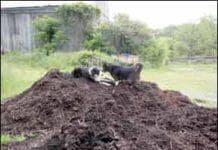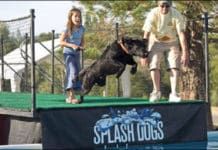Home Search
senior%20dog%20care - search results
If you're not happy with the results, please do another search
Managing Dog-Aggressive Dogs in the Family
If you do nothing else about the aggression between your dogs, you must scrupulously manage their movements and activities. Every time your dog successfully engages in a behavior that you don't want her to exhibit, it makes it that much harder to convince her that it's not a useful behavior strategy. Every time your dog aggressively communicates to another canine family member, it increases the potential for unresolvable aggression between the two and serious injury to one or both.
Thanksgiving with Dog People
In my family, thanksgiving was always the big annual holiday. We always had the usual family, friends, and food, but also lots of extended family - which includes dogs - and lots of dog-walks in the day and music at night.Happily, my sisters and I have carried on the tradition. My sister Susan has driven over from Colorado - no small feat - and dinner itself is being hosted by our other sister Pamela, who moved with her husband and their dogs to my town about a year and a half ago when her husband retired.Sue is a little sad; she's brought her (adult) daughter's little long-haired Chihuahua, Riot, who is heading to a new home.
WDJ’s 2016 Approved Gold Star Canned Dog Foods
The following pet food companies not only offer wet dog foods that meet our ingredient selection criteria, but also provided Whole Dog Journal with independent, third-party laboratory nutritional analyses of their dog foods analyses confirming that their canned dog foods are not just formulated to meet
Mid-life Surveillance
I'm the owner of two middle-aged dogs. I'm also a friend to many people with senior dogs with serious medical conditions. I've started worrying about my middle-aged dogs, especially Otto, my 70-pound wonder mutt / heart dog." (Small dogs live longer
Dr. Taylor
In the upcoming April issue of Whole Dog Journal, new contributor Cynthia Foley discusses 10 tips for senior dog care" - things that you can do to help your senior stay healthy longer! She quotes a couple of our favorite veterinary sources
Get Your Dog’s Bloodwork
When it comes to that most primitive part of us, there's nothing as basic as blood. In virtually every culture across the planet, blood represents the stream of life itself. Because its looping path always leads it back to the heart that great repository of emotion blood has come to represent all that truly matters to the human spirit: passion, heritage, mortality, atonement, commitment, sacrifice, even our connection to the divine.
Tips on Adding a Dog to Your Household
We currently have three dogs. We lost our Scottie a few months ago to cancer, and our Australian Shepherd last year to old age and failing health. This is the fewest number of dogs we've had in our family for as far back as I care to remember, and while I grieve Missy and Dubhy's absence every day, a part of me feels some guilty relief that the canine chaos and caretaking load has lightened somewhat. Still, while I know it won't be for a while yet, another part of me contemplates the next potential pup-addition to the Miller pack . . . which leads me to contemplate the complexities and challenges of bringing home a new dog.
Take Your Water-Loving Dog Dock Diving!
Summer! It's the perfect time for dock diving. In this canine sport (also known as dock jumping), the participating dog jumps off an elevated diving platform into a portable pool and the dog with the longest jump is deemed the winner. I think dock diving is possibly the best canine sport for spectator enjoyment. And, if you decide to compete, you can easily redline the FUN meter! Besides the joy of hanging out with my dog by a cool body of water, the one thing I love about the sport is that with just a few dog and handler skills, any person and any breed of dog and size of dog can participate.
Pet Food Companies and Animal Research: What Do They Do?
In recent years, the pet food industry has discovered the benefit of sharing more information about its products, manufacturing and research and development with consumers. In a highly competitive market, it's advantageous to project a confident image of full transparency - as long as the company is doing everything they say they are doing. In the wake of a substantial amount of bad PR from a nearly decade-old PETA campaign showing conditions of research animals, Whole Dog Journal had the opportunity to conduct extensive tours of two large pet food manufacturers' research facilities.
How to React to a Dog’s Bully Behavior
There’s nothing like a good dog-pack hike to give our canine companions an opportunity to have fun with their peers and run themselves into a happy state of exhaustion – provided there are no canine bullies in the group. Just like human bullies on a school playground, canine bullies take the fun out of the game, put everyone on edge, and bring to the party a real risk of physical as well as psychological damage. A dog who is bullied, especially at a young age, can quickly develop a negative association with other dogs and become defensively aggressive as a result.
Are Raw-Fed Dogs a Risk?
Delta Society is one of the largest and best-known organizations that registers and insures “pet therapy” volunteers and their companion animals. Pet/handler teams – known as Pet Partners – brighten lives in hospitals, nursing homes, group homes, schools, pre-kindergarten programs, libraries, jails, women’s shelters, homeless shelters, senior centers, adult day programs, and a host of other facilities. But on May 19, Delta Society triggered a firestorm of controversy, complete with conspiracy theories, angry denunciations, frustration, and confusion, when it announced that effective June 30, “any dog or cat from a household where raw protein food is fed is not eligible to be a Delta Society Pet Partner.” Delta’s Raw Protein Diet Policy raises serious questions about the safety of feeding raw food regardless of an animal’s pet-therapy status.
Dock Diving: A Dog Jumping Competition
A Labrador leaps into a pool in a Splash Dogs contest, one type of dock jumping.












